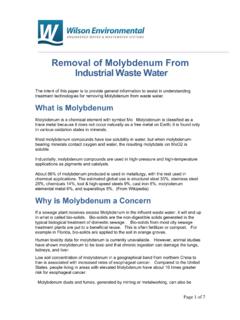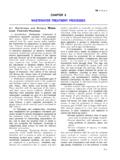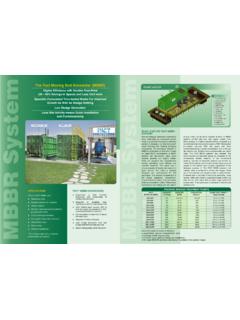Transcription of Removing Heavey Metals From Wastewater - …
1 1 Removing Heavy Metals From Wastewater by Hydroxide Precipitation Introduction: The intent of this paper is to provide general information to assist in understanding chemical treatment systems commonly used to remove heavy Metals from Wastewater by hydroxide precipitation. Heavy Metals include; cadmium, chromium, copper, lead, mercury, nickel, silver and Zinc. Definitions Caustic: Caustic is another name for sodium hydroxide (NaOH). When added to water caustic will raise the pH making the water alkaline (pH >7).
2 Increasing the amount of Hydroxide in the Wastewater . Chelating Agents: Chelating agents are compounds that are commonly used in cleaners, especially Alkaline cleaners. Common chelates are Ethylenediaminetetraacetic Acid (EDTA), Nitriliacetic Acid (NTA), Hydroxyethlenediaminetriacetic (HEDTA), Diethylenetri Aminentaacetic (DTPA) citric and oxoic acids. Chelating agents form metal complexes with heavy Metals , making removal by hydroxide precipitation difficult. Equalization Tanks: Equalization tanks are required for most Wastewater treatment systems to provide a consistent flow rate and consistent characteristics.
3 Equalization tanks are used to collect Wastewater over a period of time that is sufficient to equalize the flow so that the Wastewater system receives a Wastewater stream that is as consistent as possible. As a rule of thumb. If the total flow occurs in less than 10 hours a day or if the characteristics of the Wastewater varies from day to day an equalization tank is required. The actual size will of course be based on a case by case basis. Heavy Metals : The Heavy Metals are elements with high atomic weights, eg: cadmium, chromium, copper, lead, mercury, nickel, silver and Zinc.
4 Heavy 2 Metals can damage living organisms at low concentrations and tend to accumulate in the food chain. Industrial Wastewater : Industrial Wastewater may be composed of various chemicals, toxins, heavy Metals , pharmaceuticals, petroleum based oils and greases. By weight industrial Wastewater varies considerably and may have as much as 5 % solids. Industrial Wastewater Permits: All industrial discharges to a public sewer system are subject to general and specific prohibitions identified in the Code of Federal Regulations identified in 40 (CFR) which prohibits the discharge of any pollutant that may impair worker or public health and safety, or that might upset or pass through the Wastewater treatment plant untreated.
5 Always check with your local sewage treatment authority for permit requirements. Ions: An atom or group of atoms with an electric charge. The charge is generated by the atom gaining or losing an electron, usually through bonding. Forming either a Cation or an Anion. Cation: An atom loses electrons and has a positive charge, example: Ca2+. Anion: An atom gains electrons and has a negative charge. example: Cl-. metal Ions: Metals usually form cations, having a + charge, while non- Metals usually form anions, - metal Hydroxide: metal hydroxides are formed when a hydroxide ion (OH-) bonds to the metal ion forming an insoluble metal precipitate.
6 This occurs when caustic or lime is added to water containing heavy Metals to form the metal hydroxide solid or precipitate. pH: pH is a measure of how acidic or basic a solution is. In technical terms pH is a measure of the concentration of Hydrogen Ions or of Hydroxide Ions. The pH scale runs from 0 to 14. From 0 pH to 7 pH is acidic, having more Hydrogen Ions, and from 7 pH to 14 pH is basic, having more Hydroxide Ions, also called alkaline. A pH of 7 is neutral, having an equal number of Hydrogen Ions and Hydroxide Ions.
7 Polymers: Very long chain molecules that act like nets in the Wastewater to entangle and trap particulate matter to create flocs. As the particulate matter is trapped, the trapped material begins to increase in size and form flocs. The flocs will tend to settle and can be easily separated. 3 Precipitate: An insoluble solid. Solubility: Is a materials ability to dissolve into solution. Materials are generally classified as either soluble or insoluble. Soluble: Material readily dissolves and is not in a solid form .
8 Insoluble: Materials that do not easily dissolve and tend to stay in solid form . Solubility Curves: A graph that shows the solubility of a metal at varying pH values. Also known as speciation curves, because the graph shows where the metal ion is converted to a metal hydroxide. Basic Chemistry The chemistry of Metals removal is to covert the dissolved metal ions to an insoluble metal hydroxide that will precipitate and be removed form the Wastewater allowing the treated Wastewater to be discharged to the local sanitary sewer.
9 Precipitation of heavy Metals in Wastewater is dependent on two factors. The concentration of the metal ion and on the pH of the Wastewater . Heavy Metals in Wastewater are usually in trace amounts (1 mg/l to 100 mg/l) and are usually present in neutral to acidic pH values. The lower the concentration of the metal ion the more difficult it is to remove. When caustic or lime is added to Wastewater that contains dissolved Metals the metal ion reacts with the Hydroxide Ion to form an insoluble metal Hydroxide. metal + Hydroxide (caustic or Lime) = metal Hydroxide Precipitate The solubility curve below shows the relationship between various metal ions and pH.
10 The Y axis shows the concentration of the metal in the Wastewater and the X axis shows the pH. For Example: To remove copper (Cu) from Wastewater the line on the graph shows a drop in Cu concentration as the pH is raised. A pH of about (low point of the Cu line) as shown on the graph is optimal for Removing Cu. Higher pH values higher than are not advantageous. 4 For Zinc (Zn) note that a pH of to is the low point and is therefor the desired pH value to remove zinc. Figure 1 Solubility Curves 5 Multiple Metals in Wastewater : When more that one metal is present the pH value is generally adjusted to the average pH value.







